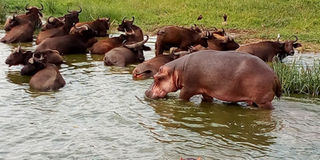Hippos, buffaloes and the Kazinga Channel

Schools of hippos and gangs of buffaloes are a common sight on the Kazinga Channel. FILE PHOTO
What you need to know:
- Breathtaking. Sights that leave you gaping in Queen Elizabeth National Park, as Roland D. Nasasira explores.
- We were also told that buffaloes rest in gangs while on the shores as a mechanism of protection from predatory crocodiles that were just in a close range from where they rested.
One recent Saturday morning, myself and a group of three Belgians and three other Ugandans begin our road trip to western Uganda from City Square in Kampala. Since most travellers on the team had neither crossed, nor taken photos at the equator, we chose to drive through Masaka Road, through Lwengo, Lyantonde, Mbarara and Bushenyi districts and finally Kasese. Kasese is home to Queen Elizabeth National Park, which was our destination. We were also to have the highlight of the day on a boat cruise in the park on the Kazinga channel that joins Lake Edward and Lake George.
When we reached the equator at Kayabwe, the photo shoot was cut short by the increasing rain as the weather got colder. When we realised that we were running out of time for the boat cruise in Kasese, the planned stopovers had to be eliminated from the itinerary.
The drive through Bushenyi was all bumpy due to patched road sections and road works which slowed down the driver’s careful speed. It took us about 90 minutes to drive through the area under construction. The clock was ticking towards 2pm and this meant that were likely to miss the boat cruise that starts at 3pm.
When we eventually manoeuvred through Bushenyi tea plantations, corners and crater lakes, we were in sight of Queen Elizabeth National Park. Everyone in the car was anxious to set their foot on the boat to sail through the national park. We arrived at the boat docking point 10 minutes before the boat set off.
Cruising the Kazinga channel
The last time I had familiarised myself with the Kazinga channel was when my primary school Social Studies teacher asked me to draw the Ugandan map and indicate its physical features, including the Kazinga channel. What made the difference this day was that I had set foot on the channel.
Schools of hippos and gangs of buffaloes
Aboard the boat with colleagues, admiring the beautiful view and scenery of the waters, the park vegetation and animals was all that there was to feed our eyes on. It was at this point that my colleagues and I were approximately seven metres from what the tour guide told us were schools of hippos and a gang of buffaloes. A hippo school is one where many hippos gather by the lake or water side when the sun gets hot, with their backs protruding through the water.
We were also told that buffaloes rest in gangs while on the shores as a mechanism of protection from predatory crocodiles that were just in a close range from where they rested.
The boat cruise also provided us an opportunity to see a yawning hippopotamus. Unlike buffalos, hippos at times move in the water independently without fear or worry of being predated on. We were told that hippos have slippery bodies and that most of them spend their time in water to cool their thick bodies from hot temperatures especially during the dry season.
The eagle and crocs
Organised by Steadfast Safaris and Tours, a boat cruise on the Kazinga channel which lasts two hours up to 5pm is one place to be for birders. It has a rich variety of birds such as the eagle. The tour guide told us that it keeps within a one-square kilometre radius from its territory. He added that when its partner dies, it does not remarry.
As we sailed, we also chanced on young ones of crocodiles called hatchlings. Unlike the mother crocodiles, hatchlings move in groups. They are as small as lizards that move on walls but become bigger as they grow. One female crocodile produces up to 50 hatchlings at once.
Crossing the border on water
Unlike by road, crossing the Ugandan border into DRCongo for approximately five minutes, back into Uganda was also breath-taking. It was at this point that two mainlands appeared to come into contact with each other, creating a thin water body line that makes up the Kazinga channel. It is only sailors who crossed and sailed deep into DR Congo on Lake Edward.
If you asked me how I would want to spend the rest of my days, cruising the channel makes the list.




